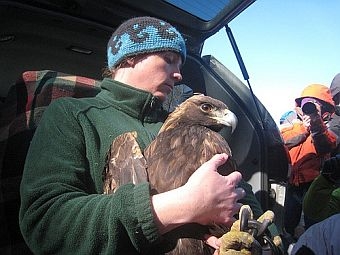 (Host) It’s not that unusual to see bald eagles in parts of the Northeast, but golden eagles are rare here. In all there are only one to two thousand in eastern North America.
(Host) It’s not that unusual to see bald eagles in parts of the Northeast, but golden eagles are rare here. In all there are only one to two thousand in eastern North America.
As part of a collaboration of Northeast public radio stations, WNPR’s Nancy Cohen reports from a windswept hilltop in Connecticut where a rescued Golden eagle was released into the wild.
(Cohen) One day this winter Farmer Brian Hawks was snowmobiling in Amenia, NY, when he saw something on the side of the trail. It was a Golden eagle with an injured foot.
(Hawks) "I didn’t know what it was and I walked over to it and it spread its wings up. Then it tried to get away and its foot was clubbed up."
(Cohen) The chocolate brown bird had a sharp beak and a splash of yellow feathers on the nape of its neck. Hawks threw his coat over the bird, placed it on his lap and snowmobiled away. Eventually it was brought to the Tufts University Wildlife Clinic in North Grafton, Massachusetts. Veterinarian Emily Christiansen says the wounds on the bird’s leg healed quickly, but the foot was worrisome.
(Christiansen) "Because a bird of prey that can’t use its foot we can’t release it."
(Cohen) These birds use their feet not only to perch, but to catch and carry prey. This bird’s foot eventually got better after more than a month at the Tufts Clinic. And it had the chance to spread its wings a bit, kind of like physical therapy, inside a flight barn
(Christiansen) "It looked surprising small with an eagle in it. We’re used to red tail hawks and barred owls and they looked like they had all the space in the world. He definitely struggled a little bit."
(Katzner) "We’ll probably need some space to do this. And what I’d like to get pictures of the front and the back of the bird. Could you take that wing?"
Conservation Biologist Todd Katzner is standing on a windy ridge in Goshen, Connecticut. He stretches out the big bird’s wings, about a seven-foot span.
Earlier Katzner had outfitted this bird with a kind of tiny backpack that carries a device that will track its flight, powered with solar rechargeable batteries.
(Katzner) "It’s going to collect GPS data points every 15 minutes. It’s going to store them and then once a day it’s going to try to send those data over the cell phone network."
(Cohen) And if it can’t get cell service the unit can store up to a summer’s worth of data points before sending them back.
Golden eagles in the east nest in Labrador, Ontario and Quebec in the summer. And winter either in Northern New York or Maine or further south in the Appalachian Mountains
Katzner, who is based at West Virginia University, gets some of his funding from the U.S. Department of Energy. He’s trying to track the Golden eagle’s movements so he can build a model to predict where to build wind turbines that aren’t on the Golden eagle’s flight path.
(Katzner) "We’ll have a map that basically shows areas of high and low risk to birds from the development of wind turbines. So that people can put turbines in places that are safe for Golden eagles and they can avoid places that are dangerous."
(Cohen) Katzner says in California, on average, 70 of these birds are killed every year at Altamont Pass, one of the country’s earliest wind farms with more than 5000 wind turbines. It was built on a migration corridor for raptors, like Golden eagles. But there are no reports yet of these birds being killed by wind turbines in the Northeast.
With the GPS unit snugly in its place veterinarian Emily Christiansen places the bird on the ground. Without hesitation the Golden eagle spreads its wings and takes off directly into the wind.
Brian Hawks, who had rescued this bird, had a big smile on his face.
(Hawks) "Pretty special, watching him fly away!"
Scientists predict the bird will head north to breed in Canada. They’ll be able to kind of ride on the bird’s shoulder, followings its movement across the landscape.
For VPR News, I’m Nancy Cohen
(Host outro) Northeast environmental reporting is made possible, in part, by a grant from United Technologies.